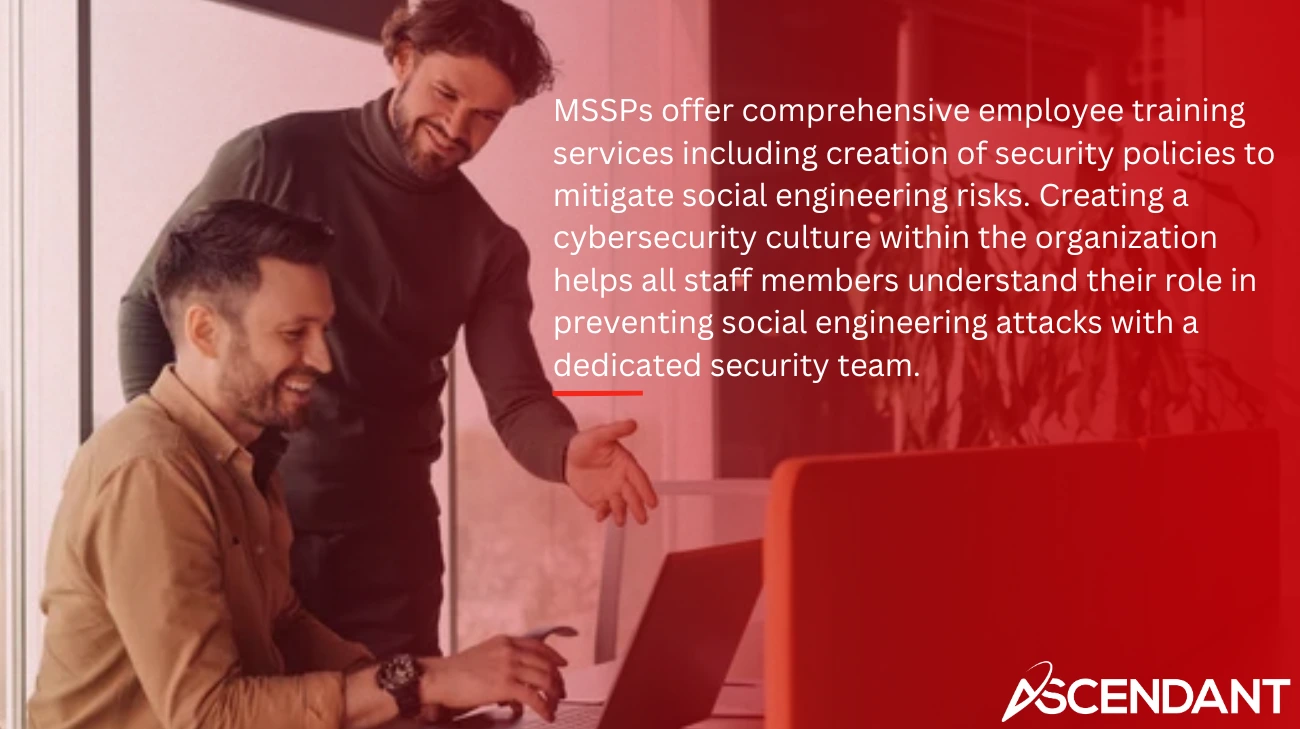Social engineering attacks target human behavior, so they’re a big threat to your business. Managed Security Service Providers (MSSPs) are on the front lines, using a combination of advanced technology, employee training and continuous monitoring to stop these tactics. Here’s how MSSPs prevent social engineering attacks and what you need to know.
In This Article:
- What are Social Engineering Attacks?
- How MSSPs Prevent Social Engineering
- Employee Training and Awareness Programs
- Simulated Phishing Campaigns
- Advanced Email Security Solutions
- Multi-Factor Authentication (MFA) Implementation
- Continuous Monitoring and Incident Response
- Endpoint Protection and Network Security
- Policy Development and Enforcement
- Machine Learning and Artificial Intelligence
- Security Assessments
Key Points
- Social engineering attacks exploit human psychology by getting individuals to reveal confidential information, so awareness and training are key.
- MSSPs play a big role in preventing social engineering attacks through comprehensive employee training, advanced security tools and continuous monitoring.
- Implementing multi-factor authentication (MFA) and regularly reviewing your security protocols are must-do’s to secure your business against social engineering threats.
What are Social Engineering Attacks?
Social engineering is an art of deception where attackers get individuals to reveal confidential information or perform actions that compromise security. Unlike traditional cyber-attacks that focus on technical vulnerabilities, social engineering attacks target human behavior, using psychological manipulation to get what they want. These attacks rely heavily on the human factor, so they’re hard to prevent.
Common social engineering tactics include:
- Creating a sense of fear and urgency to get individuals to make rash decisions without verifying.
- Phishing attacks that evoke emotions like curiosity or fear to get victims to click on malicious links or provide sensitive info.
- Impersonation, where attackers pose as trusted entities.
- Baiting, offering a reward to trick employees, including pretexting attack methods, using social engineering.
What sets social engineering apart from other attack methods is its focus on human psychology. These attacks exploit human error and trust, preying on individuals’ desire to be helpful or their curiosity. Understanding these tactics helps organizations educate their employees better and implement measures to stop social engineering attacks.
How MSSPs Prevent Social Engineering
Managed Security Service Providers (MSSPs) are on the front lines defending against social engineering attacks. They offer a holistic security strategy that includes various security controls and employee training. With advanced security tools and integration with SIEM, MSSPs share threat intelligence and improve their threat detection and response capabilities.
One of the services MSSPs offer is employee training and awareness programs. These programs are crucial in educating the workforce on recognizing and responding to social engineering attacks. Creating a cybersecurity culture within the organization, MSSPs reduce the likelihood of successful attacks and minimize damage. Countermeasures to social engineering threats are key and can be developed with the help of MSSPs. Fortify your defenses against social engineering and advanced cyber threats and MSSPs will help you keep your network secure and prevent security breaches.
Employee Training and Awareness Programs
68% of cyber attacks involve a human element, so employee awareness is crucial in cybersecurity. A human firewall through social engineering awareness training can reduce the likelihood of successful attacks by a significant margin, making it a must-have in any security strategy. Without proper training even the most advanced security systems are useless.
Regular training helps employees recognize the different tactics used in social engineering attacks. Training sessions ideally done monthly teaches employees to be mindful of security practices and aware of potential threats. Training users with visual reminders and engaging materials can further boost the effectiveness of these programs so each team member remains vigilant.

MSSPs offer comprehensive employee training services including creation of security policies to mitigate social engineering risks. Creating a cybersecurity culture within the organization helps all staff members understand their role in preventing social engineering attacks with a dedicated security team.
Simulated Phishing Campaigns
Simulated phishing campaigns are an effective way to strengthen an organization’s defenses against phishing attacks. Regular simulations can greatly reduce the number of successful attempts, with some organizations reporting as much as a 75 percent decrease. These exercises provide useful insights into how well employees recognize phishing attempts and show where additional training may be needed.
For phishing simulations to be successful, they should increase in difficulty over time. Starting with simple examples and progressing to more complex scenarios helps employees build their skills. The simulations should also reflect real situations employees might face so the training feels relevant and practical. Giving staff a safe environment to practice allows them to develop confidence in identifying and responding to suspicious messages.
By improving awareness and response skills, simulated phishing campaigns help organizations find weaknesses and build stronger defenses. They also reduce the risk of social engineering attacks such as spear phishing by preparing employees to respond appropriately in real-world situations.
Advanced Email Security Solutions
Email is the primary vector for social engineering attacks so it’s critical to implement robust security measures. Advanced email security solutions use AI and machine learning to detect and respond to threats. Natural Language Processing (NLP) plays a big role in detecting phishing attempts by analyzing the text of the communication, identifying patterns of malicious intent. MSSPs provide tools like Email Threats Dashboard and Account View to help security teams understand and mitigate risks. A unified strategy that covers email, files and user accounts enhances overall security, reduces the risk of data breach and account compromise.
Advanced email security solutions also validate essential authentication protocols like:
- DMARC
- DKIM
- SPF
These protocols enhance email authenticity and security. Implementing these advanced tools will help organizations prevent social engineering attacks and protect sensitive information.
Multi-Factor Authentication (MFA) Implementation
Implementing Multi-Factor Authentication (MFA) is a must in preventing unauthorized access. MFA can block 99% of automated hacking attempts, making it a good defense against cyber threats. By requiring multiple methods of identity verification such as text codes, biometrics or hardware tokens, MFA will significantly increase security even if login credentials are compromised.
MFA’s ability to block access even if a password is compromised makes it a must-have in any security strategy. Including MFA in your security measures will help organizations prevent social engineering attacks and protect sensitive information.
Continuous Monitoring and Incident Response
Continuous monitoring and rapid incident response is critical for organizations to detect and mitigate social engineering attacks in real-time. Security teams use SIEM, SOAR and EDR/XDR solutions to manage risks from social engineering attacks and respond to security incidents. These tools monitor network activity and detect potential threats in real-time.
Combining advanced technologies monitoring will enhance an organization’s ability to protect against evolving social engineering threats. Continuous monitoring of critical systems and rapid incident response protocols will help organizations minimize the impact of security incidents and keep their network secure.
Endpoint Protection and Network Security
Endpoint protection and network security are part of an organization’s security posture. Email security solutions often have deployment options that fit different environments, cloud and on-premise. Jamf Protect is an endpoint security solution that prevents malware on macOS and has web threat prevention across multiple platforms.
When a user clicks a known malicious link while using Jamf Protect, they will be redirected to an informative block page and will not be able to access the harmful content. This feature helps organizations block access to known spam, phishing and malicious websites and overall security.
Implementing robust endpoint protection and network security will help organizations prevent social engineering attacks and protect critical systems and ultimately enhance the organization’s security posture.
Policy Development and Enforcement
Having clear technology usage policies is key to preventing accidental exposure to social engineering threats. Implementing role-based access controls (RBAC) limits employee access to only necessary data and systems, reducing the damage from social engineering attacks. Updating and practicing incident response plans is essential for both MSSPs and their clients to mitigate social engineering attack damage.
Documentation of simulated phishing campaigns is also important for compliance so organizations can track employee participation rates and simulation content. Developing and enforcing policies will enhance an organization’s risk management and protect against social engineering threats.
Machine Learning and Artificial Intelligence
Machine learning and artificial intelligence are powerful tools to identify social engineering threats. Advanced email security solutions use anomaly detection through social graphing to detect atypical patterns that may be social engineering attacks. Robust sandboxing will uncover deceptive tactics and evasion techniques used by attackers.
A multivector defense will dismantle the infrastructure of cyber threats by taking down malicious domains and fake profiles. Predictive analytics will allow organizations to anticipate and mitigate future cyber threats including the growing threat from a threat actor and advanced threats before they happen. Understanding the tactics of threat actors will enhance these defenses against evolving threats and sophisticated threats.
Using machine learning and AI will help organizations stay ahead of attackers and reduce the risk of social engineering attacks.
Security Assessments
Security assessments are essential to identify vulnerabilities and prevent social engineering attacks. MSSPs should work with CISOs to do thorough risk assessments and identify vulnerable points in an organization that can be exploited by social engineering. Making sure software is patched and hardware firmware is up to date is key to preventing vulnerability exploitation.
Replacing deprecated programs or devices as soon as possible will keep the security posture strong. Regular evaluation of security protocols will highlight vulnerabilities in an organization’s defenses against social engineering and prevent security incidents and protect critical systems from high risk.
Summary
In summary, preventing social engineering attacks requires a multi-faceted approach. From employee training and simulated phishing to advanced email security solutions and continuous monitoring, MSSPs are key to securing organizations. By using machine learning and AI, MFA and security assessments, organizations can stay ahead of evolving threats and protect their data.
 Frequently Asked Questions
Frequently Asked Questions
What are the three key prevention measures of cyber-attacks?
To effectively prevent cyber attacks, organizations should prioritize strong authentication, robust access controls, and regular patch management. Implementing these measures will significantly enhance your security posture.
What is the best countermeasure against social engineering attacks?
The best countermeasure against social engineering attacks is a combination of employee training and technical solutions such as Multi-Factor Authentication (MFA) and secure communication channels. This multi-layered approach effectively strengthens your defense strategy.
What is social engineering, and why is it a threat?
Social engineering is a deceptive tactic used by attackers to manipulate individuals into divulging confidential information or breaching security protocols. It poses a significant threat because it exploits human psychology, making traditional defenses less effective.
How do MSSPs help prevent social engineering attacks?
MSSPs help prevent social engineering attacks by implementing comprehensive security strategies that include technical controls, employee training, and advanced security tools for effective detection and response. This proactive approach safeguards your organization against potential threats.
Why is employee training important in preventing social engineering attacks?
Employee training is crucial in preventing social engineering attacks because it equips staff with the skills to recognize and respond to common tactics used by cybercriminals, thereby significantly reducing the risk of successful attacks. Regular, targeted training can empower employees to be the first line of defense against these threats.

